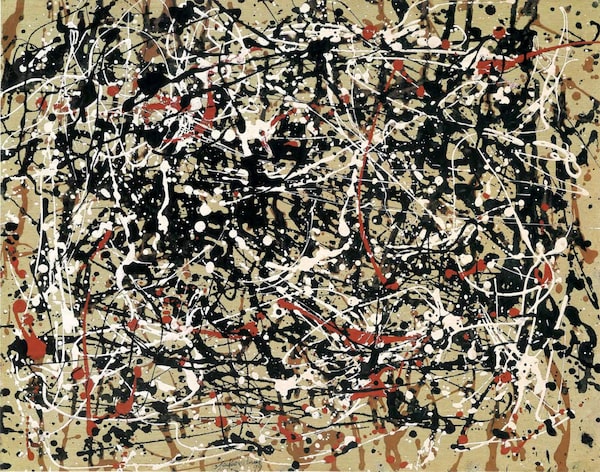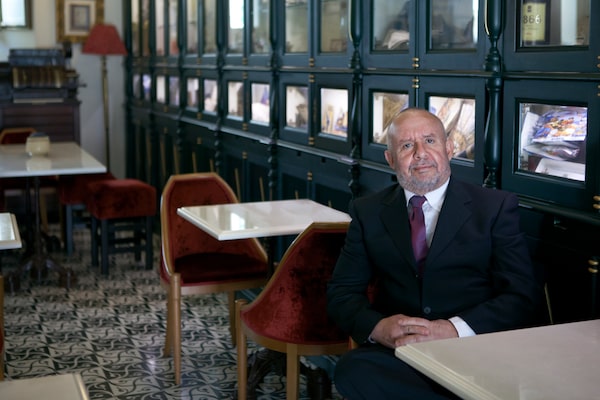
This forged work, purportedly by Jackson Pollock, was part of the largest art-fraud scheme in history.
It is not as if the contemporary art world demanded a con-job scandal to underline just how much of the scene relies on the push-pull tension of sincerity and artifice. Yet the industry was rocked all the same in 2011 after New York’s prestigious M. Knoedler & Co. gallery was closed amidst a FBI investigation into the largest art-fraud scheme in history, in which collectors were sold about US$80-million of art purported to be created by the likes of Rothko and Pollock, but was actually the work of a Chinese forger.
No stranger to chronicling the uniquely high-brow and huge-stakes scene thanks to his 2017 documentary Blurred Lines: Inside the Art World, director Barry Avrich lays out the Knoedler scandal as if it’s a tick-tock thriller in his new film, Made You Look: A True Story About Fake Art.
The doc arrives on the small screen this week in the midst of another, different kind of seismic shift in the arts-and-culture landscape. Originally scheduled to have its world premiere at the Hot Docs film festival in Toronto, Made You Look will instead air this Thursday on CBC, the Documentary Channel and CBC Gem as it kicks off the Hot Docs at Home series, a new partnership between the fest and the public broadcaster. Ahead of the unprecedented premiere, Avrich spoke with The Globe and Mail’s Barry Hertz about forgery, pride and the power of a film festival.

Barry Avrich is the director of Made You Look: A Story About Fake Art.Supplied
Why did you decide to have the film premiere now, for home entertainment, instead of waiting for whenever Hot Docs might run its big-screen festival?
Hot Docs, out of all the film festivals in the world, are so on it and active. Nobody predicted this [COVID-19 pandemic], but Hot Docs jumped on immediately, and worked with the CBC right away. I wasn’t sure it was the direction I wanted to go in, because everybody loves a film festival and the interaction with an audience that comes with it. And setting up a film for international sales without a film festival? Well, I asked a lot of questions. Would there be potential for the film to have a theatrical window after the broadcast? Yes. Would Hot Docs still be running the industry side of things, so the film had exposure? Yes. It’s jumping into the abyss and the unknown, but the silver lining is that television viewership is up now, so the film will get a strong audience versus the two or three screenings it would have got at the festival. I’m still a believer in the traditional theatrical window, but I’m well aware this might change the paradigm forever.
How did you first get exposed to this story?
A friend of mine and art collector by the name of Jay Hennick mentioned the story, and one day I had a long plane ride and printed out 500 pieces of paper on everything I could find out about it and [one-time Knoedler art dealer] Ann Freedman. But I wasn’t going to do it unless I could get Ann to speak on-camera. It wasn’t easy to convince her.
The story pivots on whether we believe Ann or not – that was she was duped like the rest of the collectors, or that she was in on it from the beginning. Where do you fall on that?
When she said she was apprehensive about being in the film, I told her, this isn’t a print story or a short 20/20 segment. This is a feature-length doc, so you have the breadth to get your story out. But I was also candid with her in that I let the audience decide where things lay. I did five interviews with her, three or four hours each time, and afterward my crew goes back and forth. After one session: she’s guilty. And the next: wow, she’s totally innocent. I go back and forth, too. For me, I don’t think she went into this with the intent to deceive. I think she believed in the paintings from the beginning and became completely overwhelmed.

José Carlos Bergantiños Díaz is the accused mastermind behind the Knoedler forgery scandal.Supplied
It seems like the modern art world is so ripe for a con like this.
It happens all the time. Of 60 paintings that were sold, 60 fakes, only 11 people sued [Knoedler]. Collectors from the beginning of time have bought fakes and just don't want to be embarrassed. So many people said to me that they trusted Knoedler as if they were going to Tiffany's. That blue box is all you need to know. It is an industry that is not regulated, there's no protection, you're buying a piece of art and you're hoping you've done your homework on provenance.
I imagine this story, and subsequent trial, won’t stop other forgers. And dealers.
This will go on and on. There’s a story about this almost every week. There’s a headline I put in the film as the paint was drying, about Prince Charles getting stuck with a bunch of fake Picassos. It’s just endless. I don’t think there’s a museum in the world, no matter in Paris or London or Toronto, that doesn’t have fakes. If a super-wealthy person has a collection and they donate it to a museum, the museum’s taking it, they’re thrilled to get it. Are they doing the due diligence to forensically test every painting? No way.
One of the collectors caught up in this was Toronto’s David Mirvish. But he’s not on-screen in your film.
David declined to be involved in the film but wrote back to say that his mother taught him that if he doesn't have anything nice to say don't say it.
Made You Look: A True Story About Fake Art premieres April 16 at 8 p.m. ET on CBC, repeating at 9 p.m. on the Documentary Channel, and will then be available to stream on CBC Gem
This interview was condensed and edited.
Plan your screen time with the weekly What to Watch newsletter. Sign up today.